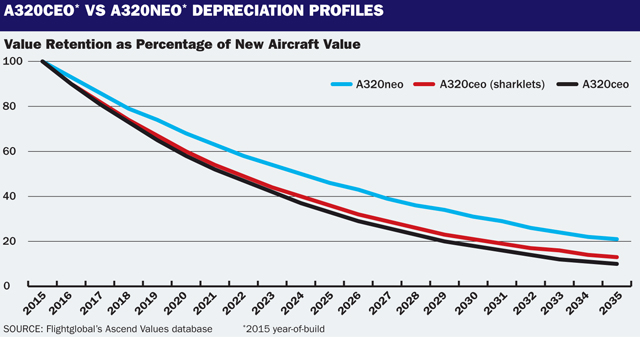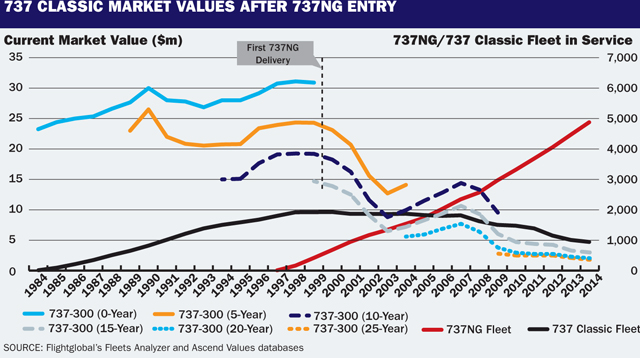The introduction this year of the Airbus A320neo by early adopters like Lufthansa commences a technology transition programme in the single-aisle market that will see the current A320ceo family end production in a few years' time, followed by the Boeing 737NG a couple of years later as Seattle completes its own transition to the 737 Max.
The A320neo, which is powered by advanced technology Pratt & Whitney PW1100G and CFM International Leap-1A engines, succeeds today's CFM International CFM56-5 and International Aero Engines V2500-powered A320ceo family. Similarly, the 737NG with its CFM56-7 engines will make way for the Leap-1B-powered Max, the first of which is set to enter service next year.
As the transition gathers pace, there are valid questions about the value impact of next-generation aircraft on the current-generation variants of A320 and 737 families, as there is close to 11,500 in service and a further 2,500 still to be delivered.
One way to understand the value impact of technology transition is to consider the effect that the Boeing 737NG had on the 737 Classic. Although there are a number of differences between that last transition and the one that is commencing, it is a good proxy to begin the discussion.

As the market values chart demonstrates, 737 Classic values remained robust during the initial entry-into-service phase of the 737NG. This did coincide with a period of strong traffic demand from the global aviation sector, benefiting all single-aisle types, young and old. The impact of the global downturn (aviation downturn more than an economic one) in 2001 following the 9/11 terrorist attacks is clear, with 737 Classic values declining significantly. Although not included in the chart, 737NG values also declined during this period – albeit by a lesser quantum.
The upturn in demand in the mid-2000s drove Classic values to improve as demand globally for all single-aisle aircraft remained strong. The fleet of Classics in service remained relatively constant with limited retirements in this period, while the 737NG fleet grew significantly so that at the end of 2006, the 737NG fleet in airline service exceeded that of the 737 Classic fleet.
The downturn of 2008 precipitated another decline in aircraft values globally, including the 737 Classic. The demand recovery since then has typically driven a further recovery in aircraft values, but the 737 Classic has not benefited from this recovery. This second downturn following the entry into service of the 737NG family has seen demand for the previous generation permanently eroded in the face of sufficient supply of next-generation aircraft.
Using this simple analysis as a benchmark suggests that values of the A320ceo and 737NG should remain relatively stable (albeit gradually trending downwards) to the next macro demand and supply cycle, with values expected to recover in the upturn that will follow. Clearly, the timing and driver of each of these cycles is currently highly speculative, but with cycles typically lasting seven to 10 years in our aviation sector, the second downturn would not come before the late 2020s at the earliest. It is this second downturn that could impair 737NGs and A320ceos permanently and beyond recovery.
Although values in the macro sense are set to remain stable, there is inevitably some impact on depreciation of last-off-the-line examples of the current-generation types. The current market value of A320ceo and 737NG examples being delivered today remain in the low $40 million range which has been typical of new-build aircraft throughout the majority of these programmes' life cycles. The launch of the replacement programmes and indeed the low fuel prices we have been enjoying this year have had limited impact on fundamental demand and supply.
Nevertheless, it is an observed fact that as end of a production cycle approaches such as now in the single-aisle arena, depreciation for last-off-the-line airframes will always be higher. This end-of-production effect is already built into Ascend's future base value curves.
If we consider an A320ceo without "sharklet" wing-tips, one with sharklets, and the first A320neo in service, all manufactured in 2015, we can see rather varied depreciation profiles. Ten years from now, with zero inflation, the plain A320ceo is set to retain 33% of its new value, the aircraft with sharklets 36% of its new value, and the A320neo a much healthier 46% of its value. A bit of inflation (in aircraft values, not the basket of goods – two separate things), could help redeem all three curves and push value retention upwards such that the A320neo could be north of 50%. However, inflation in aircraft values (or lack thereof) is an entirely different topic that is probably left for a separate discussion.
Finally, where are the next-generation variants entering the market, in value terms? Despite the prevailing low-fuel price, demand for the A320neo (and latterly the 737 Max) remains strong. Most of the orderbook in the next five years is signed and sealed, with prices contractually fixed several years ago – both heavily discounted for launch customers and then heavily escalated by merciless formulae during the over five-year wait between order and delivery.

All things considered, we see a value premium of around $5 million on average for an A320neo over an A320ceo, and on the leasing front, the premium is in the region of $60,000/month. However, lessors with speculative A320neos on backlog that have not yet been placed may find themselves having to reduce the premium over the A320ceo slightly, as selling the case of lower fuel burn is not as easy in the current environment as it was a couple of years ago, especially as some economists now predict that low fuel prices are likely to linger for the next five years or so.
With the 737 Max due to enter service in 2017, the market scenario at that point is uncertain. For now, base values and base lease rates are set to be very close to those of the A320neo.
In summary, protecting the legacy products' values requires a tangible premium for the pricing of the new product, which it appears we do have, and output discipline from the manufacturers going forward, which is a bit more questionable.
In order for values of the current generation to be impacted severely, it would take three things: firstly, that they are out of production; secondly, that there is critical mass of next-generation aircraft (arguably anything from 25% to 50% of the size of the current fleet); and thirdly, that there is an economic downturn. In the absence of all three coinciding together, the transition is likely to be much more gradual, with values of the current generation bowing out in a much more dignified manner.
George Dimitroff is head of valuations at Flightglobal's Ascend consultancy
Source: Cirium Dashboard























